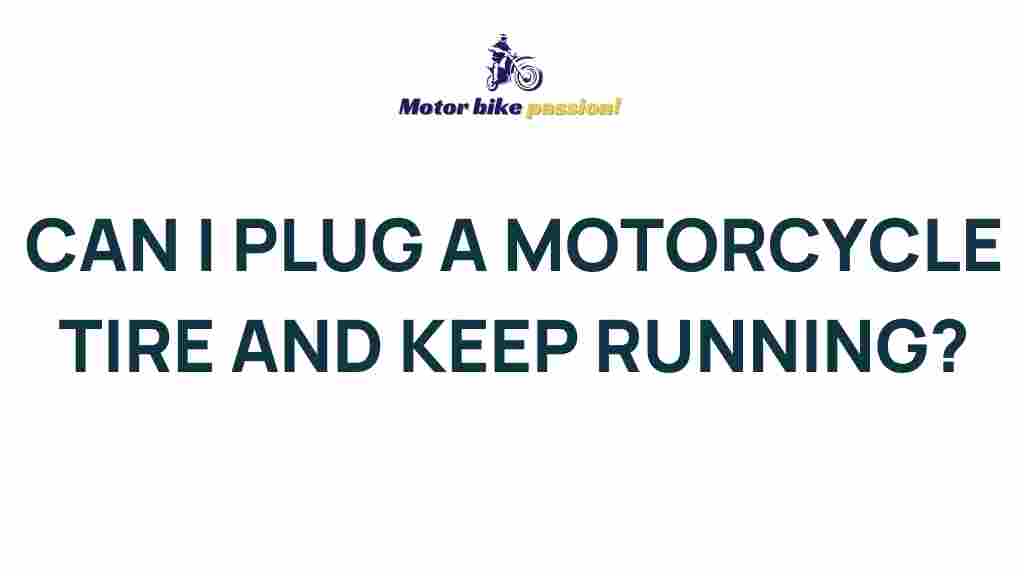Uncovering the Truth: Can You Safely Plug a Motorcycle Tire and Keep Riding?
Motorcycle enthusiasts often face one of the most inconvenient situations on the road: a flat tire. When this happens, many riders consider a quick fix by using a motorcycle tire plug. However, the question arises: is it safe to plug a motorcycle tire and continue riding? In this comprehensive guide, we will explore the safety, effectiveness, and maintenance of plugging a motorcycle tire.
The Basics of Motorcycle Tire Repair
Before diving into the safety of using a plug, it’s crucial to understand what a motorcycle tire plug is and how it works. A tire plug is a rubber or synthetic material designed to fill a puncture in the tire. This temporary repair allows the rider to continue their journey until a more permanent solution can be applied.
Understanding Motorcycle Tire Types
Motorcycle tires come in various types, including:
- Sport Tires: Designed for high performance and grip.
- Touring Tires: Built for long-distance rides, offering durability.
- Dual-Sport Tires: A blend of on-road and off-road capabilities.
- Cruiser Tires: Made for comfort and stability on cruisers.
Each type of tire has a specific construction that affects how it handles repairs. Understanding your tire’s specifications is essential before attempting any repairs.
Is Plugging a Motorcycle Tire Safe?
The safety of plugging a motorcycle tire largely depends on several factors:
- Type of Puncture: Small punctures in the tread area may be safely plugged, while sidewall punctures or larger tears usually indicate the tire should be replaced.
- Quality of the Plug: Using a high-quality plug kit will ensure a more reliable seal.
- Riding Conditions: If you plan to ride on rough terrain or at high speeds, a plug may not provide enough stability.
In general, a plug can be a safe temporary solution, but it should not replace professional tire repair or replacement.
Step-by-Step Process to Plug a Motorcycle Tire
If you find yourself in a situation where you need to plug your motorcycle tire, follow this step-by-step process:
- Inspect the Tire: Check for the location and size of the puncture. Ensure it is in the tread area and no larger than 1/4 inch.
- Gather Your Tools: You will need a tire plug kit, tire levers, and possibly an air compressor.
- Remove the Tire: If you’re comfortable, you can remove the tire from the rim using tire levers. Otherwise, consider just inserting the plug without removing the tire.
- Clean the Puncture: Use the reamer tool from your kit to clean the puncture and ensure a proper seal.
- Insert the Plug: Take a plug, thread it through the insertion tool, and push it into the puncture.
- Trim Excess Plug: Once the plug is in place, trim any excess material sticking out of the tire.
- Reinflate the Tire: Use an air compressor to bring the tire back to the recommended pressure.
- Recheck for Leaks: Apply soapy water to the area to check for any air leaks.
After successfully plugging the tire, it is crucial to monitor the repair during your next rides.
Maintenance After Plugging a Motorcycle Tire
After plugging a motorcycle tire, regular maintenance is vital to ensure ongoing safety:
- Check Tire Pressure: Regularly inspect the tire pressure and maintain it at the recommended level.
- Inspect the Plug: Periodically check the plug for signs of wear or failure.
- Avoid High Speeds: Until you can have the tire professionally repaired or replaced, avoid high speeds and aggressive riding.
Routine maintenance helps ensure that the plugged tire remains safe and functional until a permanent solution is implemented.
Troubleshooting Common Issues with Plugged Motorcycle Tires
Even with proper installation, issues may arise with a plugged motorcycle tire. Here are some common problems and troubleshooting tips:
1. Air Leakage
If you notice air leaking from the plug, consider the following:
- Recheck the plug to ensure it is seated correctly.
- Inspect for any additional punctures nearby that may have been overlooked.
- If the leak persists, it may be time to consult a professional for a full tire inspection.
2. Vibration while Riding
Excessive vibration can indicate an improper seal or tire imbalance. Address this by:
- Inspecting the tire for any uneven wear.
- Getting the tire balanced by a professional.
- Replacing the tire if necessary.
3. Plug Failure
If the plug fails, it is essential to:
- Stop riding immediately.
- Replace the tire if damage is severe.
- Learn from the experience to ensure better practices in the future.
Addressing these issues promptly will help maintain safety while riding.
When to Seek Professional Help
While plugging a motorcycle tire can be a viable temporary solution, there are times when seeking professional help is the best course of action:
- Multiple Punctures: If your tire has multiple punctures, it is safer to replace it.
- Sidewall Damage: Any damage to the sidewall typically requires a tire replacement.
- Severe Wear and Tear: If the tire shows signs of excessive wear, consult a professional.
Consulting a professional not only ensures your safety but can also extend the life of your motorcycle tire.
Conclusion
Plugging a motorcycle tire can be a safe and effective temporary repair when done correctly and under appropriate circumstances. It is crucial to assess the type of puncture, utilize quality materials, and maintain regular checks on the repair. For long-term safety and reliability, always prioritize professional inspections and repairs.
For more information on motorcycle maintenance and safety, check out our detailed guides here. And remember, keeping your motorcycle tires in optimal condition is key to a smooth and safe ride.
By understanding the process and implications of plugging a motorcycle tire, you can make informed decisions that keep you riding safely on the open road.
This article is in the category Maintenance Tips and created by MotorBikePassion Team
